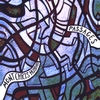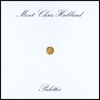Recorded on April 23rd, 2008, at Peace Church of the Brethren, in Portland, OR, with a Zoom H4 Digital Recorder. Edited with Audacity music software.
Friday, June 20, 2008
23 April 2008, #8 "Noah Adams" - 7m06s
This piece is pretty much just two chords, D and G, with a five-note motive above them (d, c#, e, b, g), elaborated and exaggerated. It also climaxes in the first minute and a half, and spends the next five winding down. It was definitely the last piece for the day.
Wednesday, June 11, 2008
23 April 2008, #4b. "Alex Cohen" - 7m41s (update)
I ended the previous piece on an open chord, and begin this one with open octaves. It quickly becomes an F minor texture. I think my attempt was to express a tonality without a meter. It's kind of like windchimes, with a limited tone range, ringing at unpredictable times. Such a "random" effect is hard to achieve with fingers used to playing predictable patterns, especially when, at the same time one is trying to move one's fingers as randomly as possible, one must still stay within a prescribed tonality (F minor).
Eventually I settle a ostinato in my right hand (c, g, c, f, e flat), discovered at 3:32, but not settled on until thirty seconds later; I noodle restively underneath it. Finally it finds a pair in the left hand, and they roll to a stop together.
Eventually I settle a ostinato in my right hand (c, g, c, f, e flat), discovered at 3:32, but not settled on until thirty seconds later; I noodle restively underneath it. Finally it finds a pair in the left hand, and they roll to a stop together.
Recorded on April 23rd, 2008, at Peace Church of the Brethren, in Portland, OR, with a Zoom H4 Digital Recorder. Edited with Audacity music software.
Friday, June 6, 2008
23 April 2008, #7. "Jack Speer" - 11m45s
I found this improv to be quite meditative for me, and fascinating to listen back, in a completely different way from most of my pieces. You'll soon notice that I repeat the same progression many times. E flat major, B flat major, E flat major, B flat major, E flat major, Bflat, F, C, G, D. I give two bars to each chord. It is a very slow cycle, almost a minute long. I stay diatonic for the first cycle, but then soon my right hand is playing all sorts of wrong-note harmony, and eventually hangs out for a while a full step away from the left. It is dissonant, but completely predictable dissonance, and I find that to be peaceful.
In the eighth minute of music, the progression is finally halted by the right hand, and it smolders a bit – the bass stays on D, and the right hand burbles in E flat. It's a lovely dark feeling that doesn't occur anywhere else in the piece.
And then suddenly the hands come together on a brilliant D major, and the progression restarts, going backwards. D major. G major. C major. F major. B flat major. E flat major... There is one small difference: the B flat and E flat get half as much time as the others (and as in the first half).
It truly feels like a slow unwinding of everything that came in the first seven minutes.
Presumably I could have unwound all the way, and then wound again, then unwound, wound, unwound, forever. Instead, after two reverse progressions, I continue (along the circle of fifths) to A flat, a key that has not been use yet in the piece, and then expand into C major and die.
Both progressions travel along the circle of fifths, but in the opposite directions, and they feel connected but contrasting. At the end of the progressions, when they restart, the first lifts (D to E flat) and the second falls (E flat to D); the former pushes forward while the latter pulls back. These intricacies (of the simplest of progressions) and their psychological implications are fascinating to me, and I could write more but I will leave the rest of the analysis to you if you so choose.
In the eighth minute of music, the progression is finally halted by the right hand, and it smolders a bit – the bass stays on D, and the right hand burbles in E flat. It's a lovely dark feeling that doesn't occur anywhere else in the piece.
And then suddenly the hands come together on a brilliant D major, and the progression restarts, going backwards. D major. G major. C major. F major. B flat major. E flat major... There is one small difference: the B flat and E flat get half as much time as the others (and as in the first half).
It truly feels like a slow unwinding of everything that came in the first seven minutes.
Presumably I could have unwound all the way, and then wound again, then unwound, wound, unwound, forever. Instead, after two reverse progressions, I continue (along the circle of fifths) to A flat, a key that has not been use yet in the piece, and then expand into C major and die.
Both progressions travel along the circle of fifths, but in the opposite directions, and they feel connected but contrasting. At the end of the progressions, when they restart, the first lifts (D to E flat) and the second falls (E flat to D); the former pushes forward while the latter pulls back. These intricacies (of the simplest of progressions) and their psychological implications are fascinating to me, and I could write more but I will leave the rest of the analysis to you if you so choose.
Recorded on April 23rd, 2008, at Peace Church of the Brethren, in Portland, OR, with a Zoom H4 Digital Recorder. Edited with Audacity music software.
Sunday, June 1, 2008
Where are the analyses?
During my road trip (which is ongoing), I have been unable to do much more than quickly update this website and my podcast feed with pre-typed blurbs and html. Unfortunately, these paragraphs were saved on my computer, which fell into a coma about a week ago and has yet to recover. Luckily, the recordings were already uploaded to my server, so I can direct you to them, but my brilliant analyses have been lost, and darn it if I haven't got the time to relisten to my improvs and analyze them. At the end of my trip (in a few weeks) I will sit down and either get my computer the medical care it needs, or do new analyses for you. In the meantime, enjoy the recordings, free of any blather from me.
23 April 2008, #6. "Linda Gradstein" - 5m43s
After I play a particularly long, lush, and dense improv like "Margot Adler," I usually begin the next one sparsely and simply, as in this piece. It is light, simple, unaggressive, and unambitious. It is a little bumpy (by design - I didn't want it to be smooth and soothing), but not jagged. The blues progression provides even more predictability.
Finally at 4:30 it begins to build, but not in drama, only in rambunctiousness, ending energetically.
Finally at 4:30 it begins to build, but not in drama, only in rambunctiousness, ending energetically.
Recorded on April 23rd, 2008, at Peace Church of the Brethren, in Portland, OR, with a Zoom H4 Digital Recorder. Edited with Audacity music software.
Subscribe to:
Posts (Atom)




